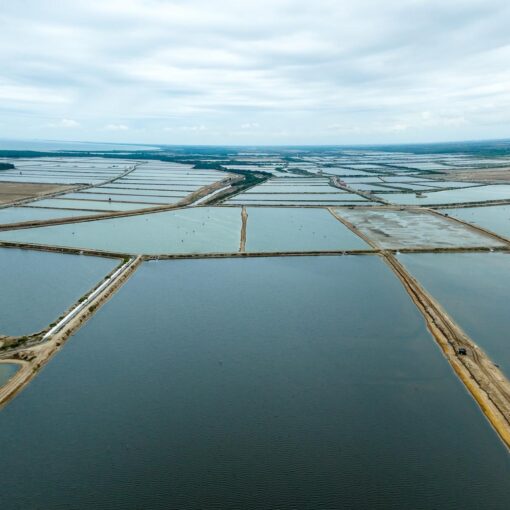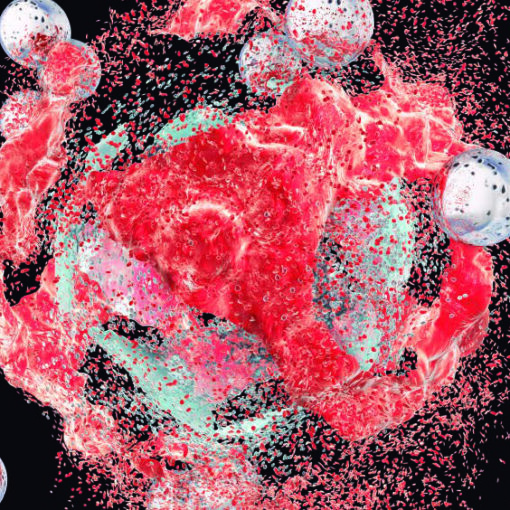* By Aquaculture Magazine Editorial Team
Excessive use of protein-rich fish feed in aquaculture ponds significantly drives methane (CH4) emissions, Mimicking biogas reactor conditions. This study reveals how anaerobic protein degradation produces nitrogen and sulfur rich compounds that fuel CH4 ebullition, with rates up to 155 times higher at feeding zones. By analyzing organic matter composition, the findings offer insight into greenhouse gas generation in aquaculture and the urgent need for more sustainable feed management strategies.
Methane (CH4) is a potent greenhouse gas, with atmospheric concentrations nearly tripling since pre-industrial times, now contributing about 25% of total atmospheric warming. Freshwater ecosystems are increasingly recognized as significant CH4 sources. In these environments, CH4 is primarily produced in sediments through methanogenesis, influenced by temperature, redox conditions, and the availability and quality of organic matter. CH4 reaches the atmosphere either via diffusion or ebullition (gas bubble release). Ebullition is particularly dominant in shallow, organic-rich systems where gas bubbles bypass oxidation in the water column, accounting for up to 80-90% of CH4 emissions.
Aquaculture ponds, which span over 8 million hectares globally, are such hotspots. These systems promote methanogenesis due to the input of biodegradable organic matter from uneaten feed, feces, and primary production. The highest recorded CH4 ebullition rate was recently reported at a fishpond feeding site. CH4 ebullition correlated more strongly with pore water-bound nitrogen (N) and dissolved organic carbon (C) than with solid-phase sediment content, highlighting the role of organic matter quality.
To characterize this quality, ultrahigh-resolution Fourier-transform ion cyclotron resonance mass spectrometry (FT-ICR MS), combined with high-performance liquid chromatography (LC), enables detailed profiling of molecular formulas (MF) in complex mixtures like water-extractable organic matter (WEOM).
This study investigates WEOM from fishpond sediment to explain high CH4 ebullition rates, comparing the feeding site to open water. Anaerobic protein degradation pathways, potentially limits by hydrolysis, may lead to accumulation of intermediates at feeding sites. This analysis aims to support improved management strategies for reducing CH4 emissions from aquaculture.

Methods
The study was conducted in Gerstenteich, a 2.5 ha freshwater pond near Bautzen, Germany, with a mean depth of 1.2 ± 0.3 m. The pond has been used for aquaculture for over 400 years. In March 2021, it was semiintensively stocked with 580 kg ha-1 of two-year-old catfish: Silurus glanis and Tinca tinca. A stationary automatic pellet feeder, dispensing feed with 45% protein, was located at the deepest point (1.65 m). By October 2021, 4,000 kg ha-1 of feed yielded 1,600 kg ha-1 of fish biomass.
No fertilization, aeration, or dredging had occurred in the past three years. The pond had no significant surface water inflow/outflow and supported submerged vegetation and phytoplankton, surrounded by a littoral belt of reeds and trees.
Ebullition was previously studied in September 2021, revealing the highest recorded CH4 ebullition rate of 1,238 mmol m-2 d-1 at the feeding site (F1), dropping to 8 ± 7 mmol m-2 d-1 beyond 20 m. Thus, the pond was divided into “feeding area” (F1-3) and “open water area” (W1-9). During the 8 months cycle, 85% of C input derived from protein-rich feed. Pore water total bound N and dissolved C strongly correlated with CH4 ebullition (R2=0.98 and 0.92), unlike solidphase sediment contents.
Fieldwork involved sediment sampling (top 5 cm) using a gravity corer, with anaerobic transport in Anaerocult® A bags. Due to precipitation in acidified pore WEOM was extracted from freeze-dried sediment using ultra-pure water, then shaken and centrifuged. Aqueous extracts were filtered (0.45 µm), diluted 1:10, and analyzed via LC-FT-ICR MS.
The LC setup included a reversedphase polar C18 column and mobile phases of ultrapure water and methanol, both acidified with 0.05% formic acid. The LC-FT-ICR MS system used electrospray ionization (ESI) in negative mode with high-resolution mass detection (m/z 147-1,000). Mass spectra were segmented into five retention time intervals, averaged, recalibrated, and assigned MFs based on stringent elemental and double bond equivalent (DBE) criteria.
MFs found in at least two-thirds of feeding area (F) or water area (W) samples were grouped into average spectra “F” and “W.” Peak magnitude changes (δRAW) indicated enrichment or repletion of compounds. Wilcoxon and t-tests were used to assess differences in sediment protein, sulfur (S), and MF classes between areas. Correlation between CH4 ebullition, sediment protein, and MF abundances were analyzed using R software for statistical evaluation and visualization.

Results and Discussion
Protein-rich feed as a driver of methane (CH4) ebullition
In the aquaculture pond Gerstenteich, protein content in sediments peaked in the feeding zone (F1) at 118.0 mg/g and declines to 33.4 ± 5.9 mg/g in open waters (Figure 1). These values surpass those reported in other eutrophic marine and aquaculture settings. The scarcity of freshwater data on sedimentary protein is likely due to the rapid degradation of proteins in natural ecosystems though aquaculture ponds, enriched by feet inputs, exhibit significantly higher nutrient loads.

Proteins accounted for 34.5% to 66.1% of organic matter depending on the site, confirming enrichment from the 45%-protein feed used. It is estimated that 4,500 kg of protein were added over the growing season, equating to approximately 720 kg of nitrogen. However, only 25% of feed- N is typically assimilated by fish, leaving 540 kg to return to the ecosystem primarily through feces ─mostly in a dissolved, microbially accessible form.
Given the fish biomass and feed conversion, about 50% of the feed-N, especially protein-N, is lost to eutrophication and sediment accumulation. This inefficiency aligns with prior findings from similar systems, where only a quarter of nutrients translate into biomass. The result is heavy sedimentation (up to 3.7 cm/ year) and high nitrogen content, consistent with observed values at Gerstenteich.
Significantly, sediment protein levels strongly correlated with CH4 ebullition (R2 = 0.58). Proteins, while initially undigestible by microbes, undergo anaerobic degradation, producing monomers like amino acids, which are transformed into ammonium and volatile fatty acids, eventually fueling CH4 production. The strong link between porewater nitrogen and CH4 ebullition (R2 = 0.98) suggest that the quality ─ specifically nitrogenrich, labile organic matter ─ drives microbial methanogenesis. This explains Gerstenteich´s extremely high CH4 ebullition rates, reaching 1,238 mmol m-2d-1.
Organic matter quality via LC-FT-ICM MS
To understand the composition of the organic matter responsible for CH4 production, researchers analyzed WEOM using LC-FT-ICR MS. The majority of compounds belonged to CHNO (35%), followed by CHOS (27%), CHNOS (22%), and CHO (15%). CHNO compounds were significantly more abundant in feeding areas (Figure 2).

A van Krevelen diagram revealed clear differences in molecular structure between feeding and open water zones. Unlike most natural organic matter, which contains up to three nitrogen atoms, the feed-derived CHNO compounds often contained up to eight nitrogen atoms ─ suggesting the presence of oligopeptides (short chains of amino acids). ChemSpider database matches confirmed the presence of such protein fragments, particularly in the feeding zone.
δRAW indicated a higher relative abundance of CHNO, CHNOS, and CHOS in feeding areas, CHNO comDa), supporting the presence of longer oligopeptides. These protein-like compounds correlated strongly with CH4 ebullition.
While CHN1O and CHN2O compounds were less abundant, likely due to their rapid degradation by microbial exoenzymes in the feeding area, larger oligo peptides persisted due to constant feed input. The microbial community seems adapted to maintain high enzymatic activity, facilitating the break down of feed proteins and contributing to CH4 generation.
Sulfur-containing compounds (CHOS, CHNOS) also showed increased intensities in the feeding area, accounting for ~50% of total detected organic matter. Although solid-phase sulfur levels were similar throughout the pond, only the feeding area has detectable sulfate in porewater, suggesting localized resuspension and oxidation of sulfur compounds due to fish activity.
High levels of CHOS and CHNOS compounds ─ often formed through abiotic sulfurization in anoxic environments ─ were found. Some compounds, like C8H13N103S1 likely originated from sulfurized oligopeptides. Their presence, even 83 meters from the feeding area, indicates widespread impact of localized feed inputs on the pond´s organic matter.

Implications for a more climate-friendly aquaculture
Aquaculture is promoted as a sustainable alternative to wild fisheries, yet current practices ─ particularly the excessive use of protein-rich feed ─ have environmental downsides. These include organic matter accumulation, anoxic sediment conditions, and elevated emissions of greenhouse gases like CH4 and carbon dioxide (CO2). In Gerstenteich, CH4 ebullition in the feeding area was 155 times higher than in open waters, driven largely by protein degradation by products.
Methane emission in this zone accounted for 98% of total pond CH4 release, with bubble gases even containing high levels of CO2 ─ unusual outside of biogas reactors. This highlights the extreme microbial activity induced by unbalanced protein inputs, essentially mimicking biogas fermentation conditions.
The observed CH4 ebullition rate (1.24 mol m-2d-1) is unprecedented in natural or aquaculture systems. Literature on biogas suggests that protein hydrolysis is the rate-limiting step in methane production. Here, >100-fold higher oligopeptide intensities at the feeding site support that analogy and emphasize the urgent need for more sustainable practices.
Scientific evidence indicates that high protein feed is often unnecessary and may even hinder fish growth. Salmon aquaculture has demonstrated that lowering protein content and optimizing feed composition improves efficiency and reduces environmental damage. Likewise, the considerable variability in greenhouse gas emissions across aquaculture systems shows that climatefriendly models are feasible.
Alternative technologies like biofloc systems, which enhance protein use efficiency and reduce organic waste, may offer a more sustainable path. However, further research is needed to evaluate their climate impact. Adjusting feed strategies and improving management practices could drastically reduce eutrophication and greenhouse gas emissions in aquaculture.
Conclusion
Aquaculture is a climate-relevant source of greenhouse gases like CH4. CH4 emissions from aquaculture systems are heterogenous and depend on various parameters, with organic matter quality playing a crucial role.
Nevertheless, little is known about the molecular composition of organic matter in aquaculture systems and the influence of applied fish feed.
We investigated the effects of excessive loading of high-protein fish feed pellets on sediment organic matter quality using a transect from the stationary feeding site to the center of am temperate, semi-intensively managed fishpond to explain the extremely high CH4 ebullition rates (bubble flux) measured. Analyzing the molecular composition of water-extractable organic matter with LC-FT-ICR MS, we found a strong enrichment of low-molecular weight nitrogen and sulphur-rich organic compounds at the feeding area compared to the open water area.
The measured CH4 ebullition correlated well with sediment protein content and total bound nitrogen in the pore water. In addition, Spearman rank correlation analysis evidenced that high protein-like component abundance drove CH4 ebullition. The results indicate that feed proteins were hydrolyzed to oligopeptides (CHNO) and drove methanogenesis resulting in CH4 ebullition rates of 1.24 mol m-2 d-1 at the feeding site. In addition, subsequent conversion to CHOS and CHNOS components during anaerobic deamination of protein and peptide fragments in the presence of inorganic sulphides was indicated.
These metabolites accumulated at the feeding area due to continuous feed supply. The findings illustrate the adverse effects of excessive protein feeding leading to bioreactor- like CH4 emissions and provide new insights into the composition and transformation of organic matter in aquaculture systems.
Aquaculture is an important contributor to global food production but often involves excessive feeding with expensive, protein-rich feeds. Improving feed management has the potential to make aquaculture more climate- friendly and sustainable and, with our study, we hope to provide further incentives to rethink aquaculture feed management.
This is a summarized version developed by the editorial team of Aquaculture Magazine based on the review article titled “N ANAEROBIC DEGRADATION OF EXCESS PROTEIN-RICH FISH FEED DRIVES CH4 EBULLITION IN A FRESHWATER AQUACULTURE POND ” developed by: Waldemer, C. – Department Lake Research, Helmholtz Centre for Environmental Research-UFZ; Lechtenfeld, O. and Gao, S. – Helmholtz Centre for Environmental Research-UFZ; Koschorreck, M. and Herzsprung, P. – Department Lake Research, Helmholtz Centre for Environmental Research-UFZ. The original article, including tables and figures, was published on SEPTEMBER 2024, through SCIENCE OF THE TOTAL ENVIRONMENT. The full version can be accessed online through this link: https://doi.org/10.1016/j. scitotenv.2024.176514










